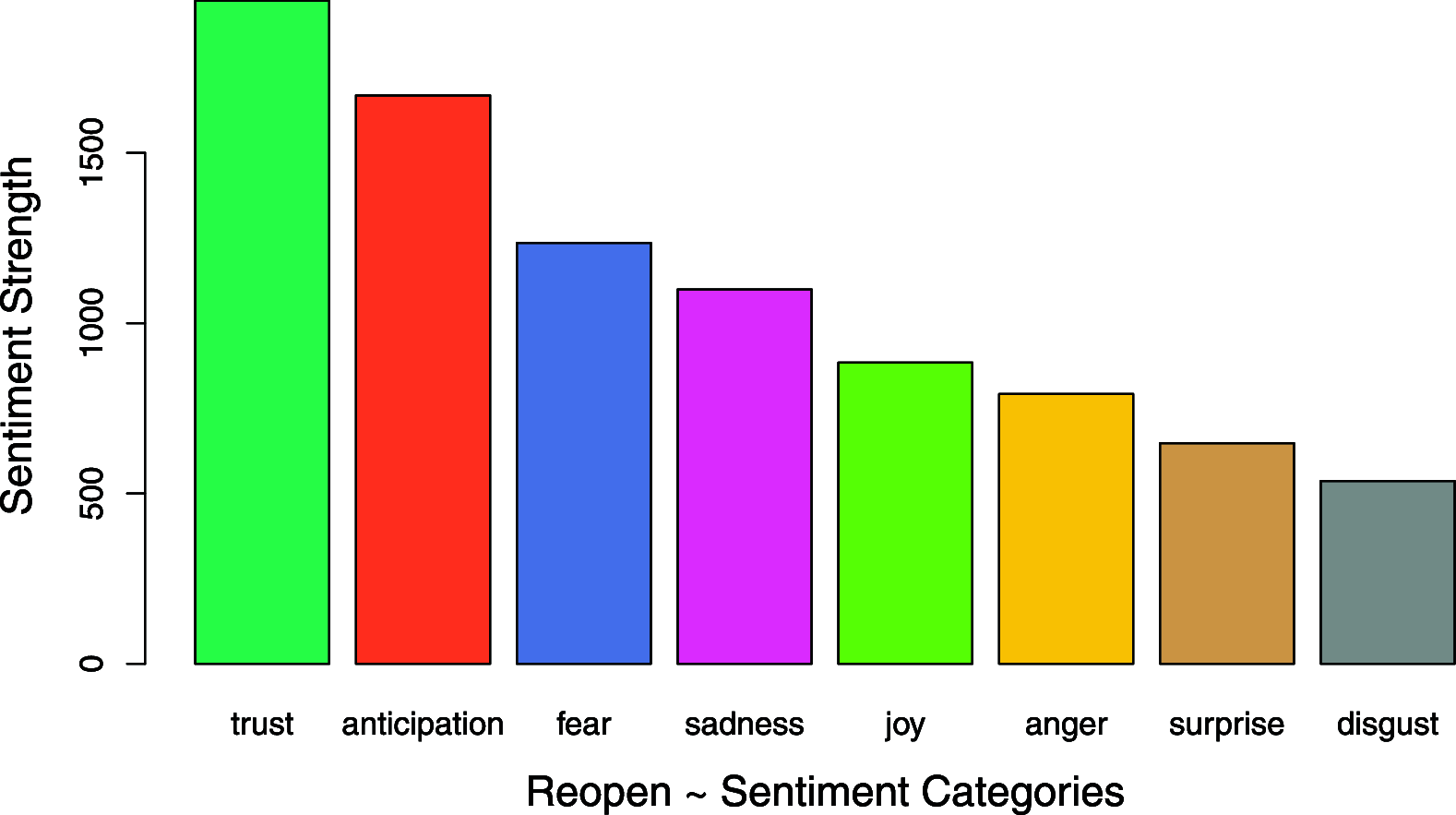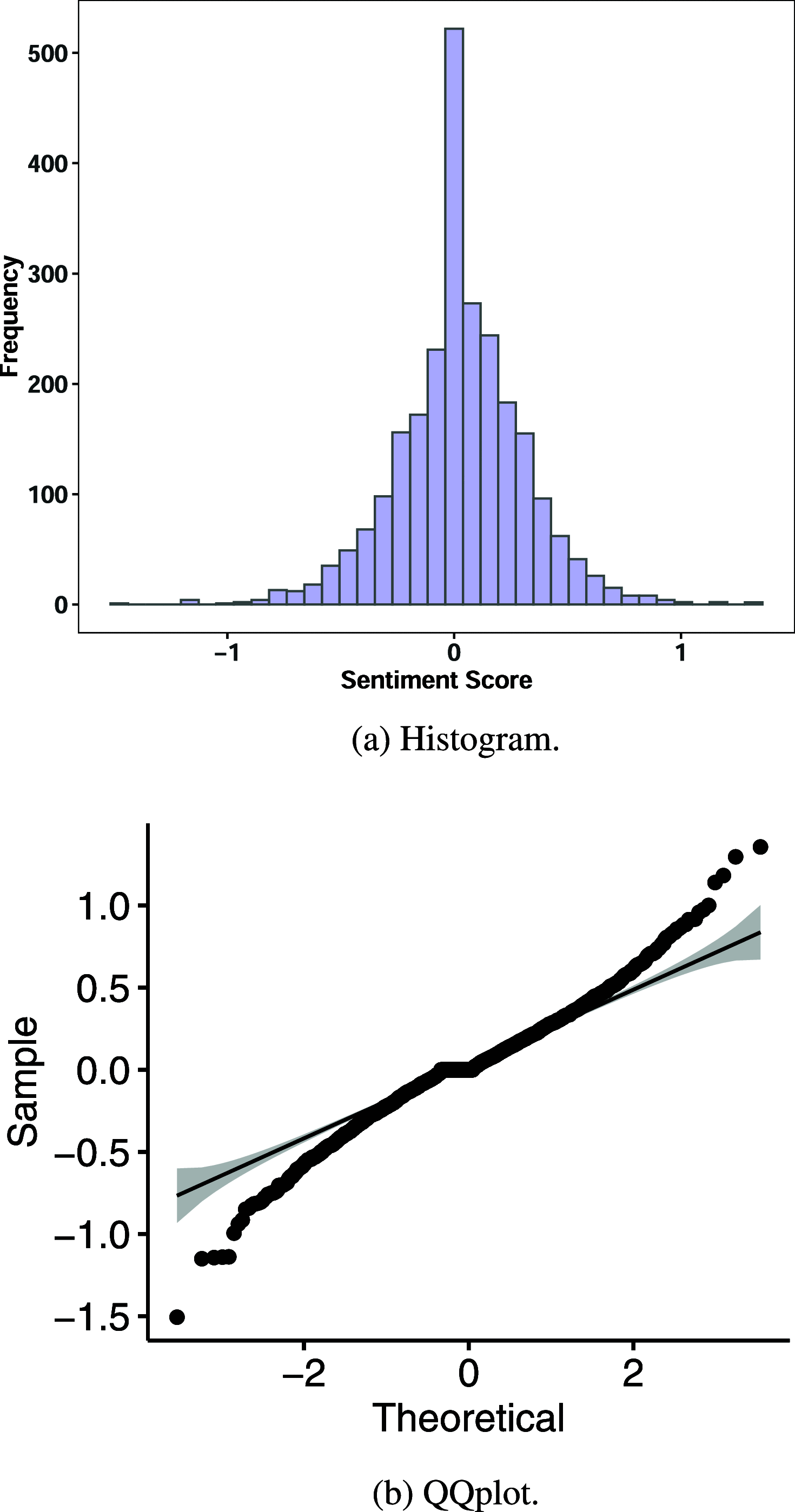Feeling Positive About Reopening? New Normal Scenarios From COVID-19 US Reopen Sentiment Analytics
- PMID: 34786280
- PMCID: PMC8545342
- DOI: 10.1109/ACCESS.2020.3013933
Feeling Positive About Reopening? New Normal Scenarios From COVID-19 US Reopen Sentiment Analytics
Abstract
The Coronavirus pandemic has created complex challenges and adverse circumstances. This research identifies public sentiment amidst problematic socioeconomic consequences of the lockdown, and explores ensuing four potential public sentiment associated scenarios. The severity and brutality of COVID-19 have led to the development of extreme feelings, and emotional and mental healthcare challenges. This research focuses on emotional consequences - the presence of extreme fear, confusion and volatile sentiments, mixed along with trust and anticipation. It is necessary to gauge dominant public sentiment trends for effective decisions and policies. This study analyzes public sentiment using Twitter Data, time-aligned to the COVID-19 reopening debate, to identify dominant sentiment trends associated with the push to reopen the economy. Present research uses textual analytics methodologies to analyze public sentiment support for two potential divergent scenarios - an early opening and a delayed opening, and consequences of each. Present research concludes on the basis of textual data analytics, including textual data visualization and statistical validation, that tweets data from American Twitter users shows more positive sentiment support, than negative, for reopening the US economy. This research develops a novel sentiment polarity based public sentiment scenarios (PSS) framework, which will remain useful for future crises analysis, well beyond COVID-19. With additional validation, this research stream could present valuable time sensitive opportunities for state governments, the federal government, corporations and societal leaders to guide local and regional communities, and the nation into a successful new normal future.
Keywords: COVID-19; Twitter; coronavirus; feeling; new normal; reopen; sentiment analysis; textual analytics.
This work is licensed under a Creative Commons Attribution 4.0 License. For more information, see https://creativecommons.org/licenses/by/4.0/.
Figures











Similar articles
-
Public Perceptions of COVID-19 Vaccines: Policy Implications from US Spatiotemporal Sentiment Analytics.Healthcare (Basel). 2021 Aug 27;9(9):1110. doi: 10.3390/healthcare9091110. Healthcare (Basel). 2021. PMID: 34574884 Free PMC article.
-
Socioeconomic factors analysis for COVID-19 US reopening sentiment with Twitter and census data.Heliyon. 2021 Feb;7(2):e06200. doi: 10.1016/j.heliyon.2021.e06200. Epub 2021 Feb 6. Heliyon. 2021. PMID: 33585707 Free PMC article.
-
Vaccine sentiment analysis using BERT + NBSVM and geo-spatial approaches.J Supercomput. 2023 May 7:1-31. doi: 10.1007/s11227-023-05319-8. Online ahead of print. J Supercomput. 2023. PMID: 37359330 Free PMC article.
-
Topics, Trends, and Sentiments of Tweets About the COVID-19 Pandemic: Temporal Infoveillance Study.J Med Internet Res. 2020 Oct 23;22(10):e22624. doi: 10.2196/22624. J Med Internet Res. 2020. PMID: 33006937 Free PMC article.
-
Twitter Discussions and Emotions About the COVID-19 Pandemic: Machine Learning Approach.J Med Internet Res. 2020 Nov 25;22(11):e20550. doi: 10.2196/20550. J Med Internet Res. 2020. PMID: 33119535 Free PMC article.
Cited by
-
The Turing Teacher: Identifying core attributes for AI learning in K-12.Front Artif Intell. 2022 Dec 14;5:1031450. doi: 10.3389/frai.2022.1031450. eCollection 2022. Front Artif Intell. 2022. PMID: 36590861 Free PMC article.
-
The Effect of Local and Global Interventions on Epidemic Spreading.Int J Environ Res Public Health. 2021 Nov 30;18(23):12627. doi: 10.3390/ijerph182312627. Int J Environ Res Public Health. 2021. PMID: 34886355 Free PMC article.
-
What social media told us in the time of COVID-19: a scoping review.Lancet Digit Health. 2021 Mar;3(3):e175-e194. doi: 10.1016/S2589-7500(20)30315-0. Epub 2021 Jan 28. Lancet Digit Health. 2021. PMID: 33518503 Free PMC article.
-
Temporal Dynamics of Public Emotions During the COVID-19 Pandemic at the Epicenter of the Outbreak: Sentiment Analysis of Weibo Posts From Wuhan.J Med Internet Res. 2021 Mar 18;23(3):e27078. doi: 10.2196/27078. J Med Internet Res. 2021. PMID: 33661755 Free PMC article.
-
Social distancing and reopening universities after the COVID-19 pandemic: policy complexity in G20 countries.J Public Health Res. 2021 Jan 27;9(Suppl 1):1957. doi: 10.4081/jphr.2020.1957. eCollection 2020 Nov 17. J Public Health Res. 2021. PMID: 33575228 Free PMC article.
References
-
- Coe E. H. and Enomoto K.. (2020). Returning to Resilience: The Impact of COVID-19 on Mental health and Substance Use. McKinsey & Company. Accessed: May 16, 2020. [Online]. Available: https://www.mckinsey.com/industries/healthcare-systems-and-services/our%...
-
- Goldmann E. and Galea S., “Mental health consequences of disasters,” Annu. Rev. Public Health, vol. 35, no. , pp. 169–183, Mar. 2014. - PubMed
-
- Moghadas S. M., Shoukat A., Fitzpatrick M. C., Wells C. R., Sah P., Pandey A., Sachs J. D., Wang Z., Meyers L. A., Singer B. H., and Galvani A. P., “Projecting hospital utilization during the COVID-19 outbreaks in the united states,” Proc. Nat. Acad. Sci. USA, vol. 117, no. 16, pp. 9122–9126, Apr. 2020. - PMC - PubMed
LinkOut - more resources
Full Text Sources
